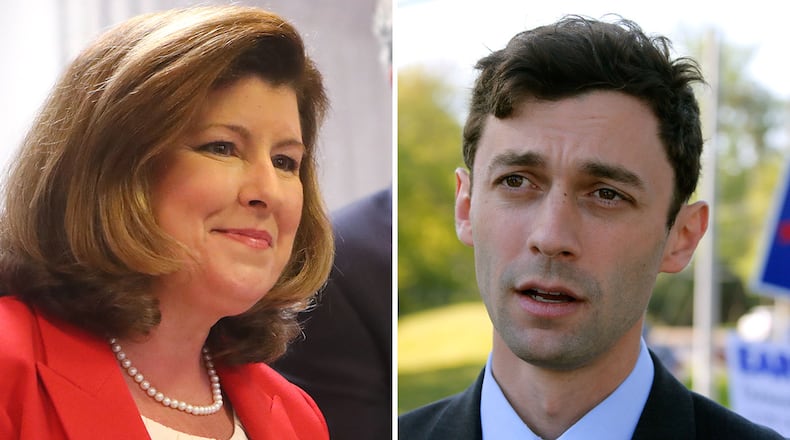There are so many ads in Georgia’s 6th Congressional District race that they are creating the news. Literally.
The tidal wave of spending led a local television broadcaster, WXIA, to temporarily add a 7 p.m. newscast on its sister station. Fans of “The Andy Griffith Show” repeats will have to look elsewhere for the next few weeks.
It’s only the latest way the barrage of outside cash and national attention has transformed the race to represent the suburban Atlanta district. Once thought to be a sleepy special election, it is now poised to be the most expensive U.S. House contest in the nation’s history.
An Atlanta Journal-Constitution analysis shows that about $15 million was spent by candidates and outside groups in the run-up to the April 18 vote, which winnowed an 18-candidate field to a pair of finalists: Democrat Jon Ossoff and Republican Karen Handel.
Since then, the flood of money has only intensified. An additional $4 million has surged into the race in the past three weeks. And records show about $11 million in ad buys have already been booked through the June 20 runoff. That’s not counting expected big expenditures from Handel’s campaign or other groups that could kick up their spending.
The $30 million sum is an unprecedented expenditure. According to the Center for Responsive Politics, a transparency advocacy group, the most expensive House race was a 2012 Florida contest between Republican U.S. Rep. Allen West and Democrat Patrick Murphy that cost nearly $29.6 million.
Why all the attention? Republicans have held the district, which spans from east Cobb County to north DeKalb County, for decades, and Tom Price won a string of landslide victories there every two years to maintain his grip on the seat. But when Donald Trump selected Price as his health secretary, the race to fill his congressional seat quickly turned into a nationally watched test of the president’s popularity.
A record-setting campaign
It’s a huge — and unexpected — boon for television, radio and cable broadcasters in metro Atlanta.
The presidential campaigns largely bypassed Georgia during the 2016 race, opting for topsy-turvy battleground states such as Florida, North Carolina and Ohio. And a weak Democratic challenge to Republican U.S. Sen. Johnny Isakson meant less statewide ad spending on his re-election campaign.
A surge in interest in Ossoff, a 30-year-old former congressional aide, has upended this race. Ossoff raked in more than $8.3 million in the first three months of his campaign — a record-setting quarterly haul for a House candidate — and he’s far surpassed that figure by now. Republican groups have scrambled to counter him, pouring millions into attack ads.
Elections records obtained by the AJC show that Ossoff recently reserved more than $5.2 million in ad time for the rest of the campaign, and the Democratic Congressional Campaign Committee has chipped in an additional $1 million. All told, Ossoff has spent or reserved more than $10.7 million for ads.
A trio of conservative groups — the U.S. Chamber of Commerce, the National Republican Congressional Committee and the Congressional Leadership Fund — have combined to account for more than $7.2 million in TV, cable and radio spending since April 18. That doesn’t include any spending from Handel’s campaign, which hasn’t aired a TV ad since her No. 2 finish.
It helps explain why reporters at WXIA showed up at a meeting last week and were informed about a temporary 7 p.m. newscast on its sister station, WATL, that will end after the June 20 runoff is over. They were told the current newscast commercial inventory was too tight.
The manager of the NBC affiliate didn’t respond to requests for comment.
Too many ads, too little time
The stations are grappling with an awkward problem: too many political ads and too few slots for them on news programs — the most-prized type of programming for political campaigns.
TV stations across the nation have temporarily extended newscasts or added programming the past few election cycles to take in more political advertising. The Washington Post reported that one station temporarily bumped daily reruns of "The Simpsons" for news, while another added two weekend newscasts during the campaign season.
Atlanta networks also have long tried to maximize political ad revenue. WSB-TV, which is owned by the same parent company that owns the AJC, occasionally programs news specials in prime time to beef up its news offerings during political races. But analysts said WXIA is the first metro Atlanta station to offer a short-term newscast timed for a special election.
“I have to give (WXIA) credit — they’re being honest about it,” said Bobby Kahn, a former Democratic operative whose media-buying firm works with Ossoff’s campaign. “I’m never surprised at a television station’s efforts to maximize their political revenue.”
The tight timing of a nightly newscast also adds another wrinkle. Michael Castengera, a TV consultant who teaches at the University of Georgia’s Grady College of Journalism, said stations try to space out ads to avoid airing them back-to-back. That means a typical 30-minute newscast can fit 16 to 18 30-second ads, he said.
And they have to strike a balancing act between serving longtime advertisers who provide a steady stream of revenue and the spike in political ads from campaigns who can generally buy their airtime at cheaper rates.
Networks and cable TV stations reject the political ads at their own risk. Trump’s campaign assailed CNN last week for rejecting an ad that labeled one of its anchors “fake news.”
The glut of spending has only increased since the U.S. Supreme Court’s landmark Citizens United decision in 2010. That ruling created a new class of super PACs by removing limitations on political contributions by individuals and corporations, creating an enormous new stream of revenue to back candidates or special interests in political races.
And that means more ads that will follow you wherever you go — on the nightly news, the car radio, the desktop computer and the mobile phone. And it could mean even more experimentation like the WXIA decision to bump Mayberry’s finest for a few weeks.
“There are going to be a lot of Andy Griffith fans who are going to be upset,” Kahn quipped.
Well, they can still catch Andy, Barney and Opie at 7:30 p.m.
About the Author
Keep Reading
The Latest
Featured




